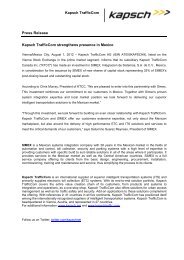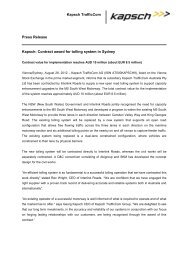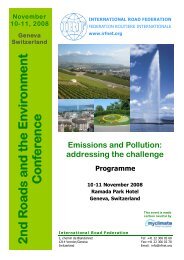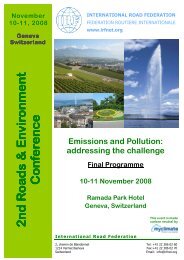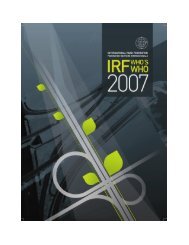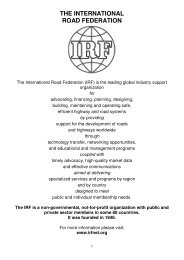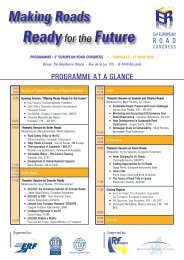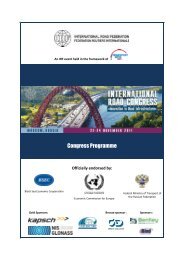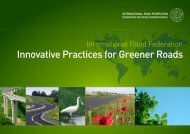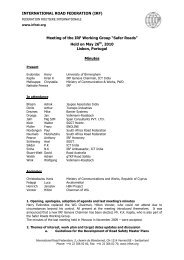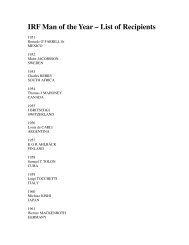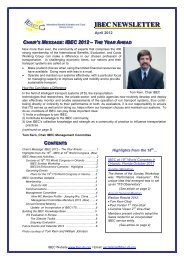Motorways and Urban Mobility - International Road Federation
Motorways and Urban Mobility - International Road Federation
Motorways and Urban Mobility - International Road Federation
You also want an ePaper? Increase the reach of your titles
YUMPU automatically turns print PDFs into web optimized ePapers that Google loves.
05<br />
ROAD CONSTRUCTION<br />
Hong Kong, 1029<br />
Ho Chi Minh,<br />
500<br />
Hanoi, 500<br />
Kathm<strong>and</strong>u, 305<br />
Colombo, 170 Lanzhou, 204<br />
Dissecting the available guidelines <strong>and</strong> contrasting them<br />
with pedestrian needs, it is clear that there is a need urgently<br />
to overhaul the prevailing provisions for pedestrians in<br />
Asian cities. The current guidelines are often ambiguous or<br />
inequitable, <strong>and</strong> rarely enforced.<br />
Clearly, there is a need to change the character of Asian<br />
streets by giving due consideration to pedestrians as<br />
the primary consumers of the road space, rather than<br />
retrofitting to their needs at a later stage. Similarly, it is<br />
imperative to adopt guidelines that are better suited to<br />
the full context <strong>and</strong> character of pedestrian needs, <strong>and</strong><br />
the l<strong>and</strong> use choices required to address them equitably<br />
<strong>and</strong> effectively. Many Asian cities still need to develop<br />
well-designed, shared roads, with traffic calming facilities,<br />
in order to accord due priority to pedestrians <strong>and</strong> provide<br />
complete streets.<br />
Streets which are accessible for all, <strong>and</strong> which grant priority<br />
to the most vulnerable travellers!<br />
| IRF BULLETIN SPECIAL EDITION: URBAN MOBILITY<br />
Jakarta, 250<br />
Kota, 256<br />
Ulaanbaatar, 266<br />
266<br />
Karachi, 272<br />
Manila, 304<br />
Pedestrian interview<br />
survey respondents<br />
Table 2: Results of pedestrian interview survey<br />
Davao, 287<br />
Cebu, 301<br />
36% of respondents consider the pedestrian environment to be in the “bad” or<br />
“worse” categories.<br />
49% of respondents prefer to cross at grade crossings, whereas only 15% were<br />
interested in using subways.<br />
Nearly 45% of respondents are only willing to walk 50 metres to access crossings.<br />
Nearly 33% are willing to walk 100m to access pedestrian crossings. This is critical<br />
as many traffic codes prescribe 200-300m as crossing separations.<br />
If the walking environment is not improved, 82% of respondents indicated that<br />
they would shift to other modes. This is critical as it would increase motorisation<br />
<strong>and</strong> exacerbate externalities such as climate change.<br />
65% of respondents believe that they are most exposed to air pollution when<br />
walking or waiting for buses.<br />
Respondents considered the areas surrounding public transport terminals to have<br />
the worst ‘walkability’.<br />
30% of respondents have trip lengths of less than 3 km. This indicates that by<br />
providing connectivity <strong>and</strong> utilising urban solutions, significant numbers of people<br />
could walk to their destinations, provided sufficient facilities are in place.<br />
Pedestrian overpass in a relatively low vehicle traffic area on a<br />
two lane road in Cebu city. Infrastructure for whom?<br />
Acknowledgements: This paper borrows insights from the Asian<br />
Development Bank’s forthcoming publication “Walkability in Asian<br />
Cities”. The authors wish to thank the Bank’s Jamie Leather as well as<br />
CAI-Asia colleagues <strong>and</strong> Clear Air Partnership members for their help<br />
in conducting the surveys.






